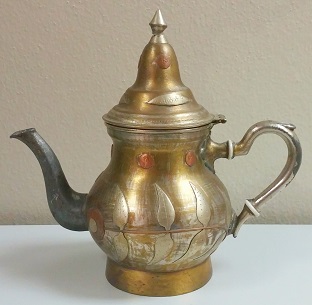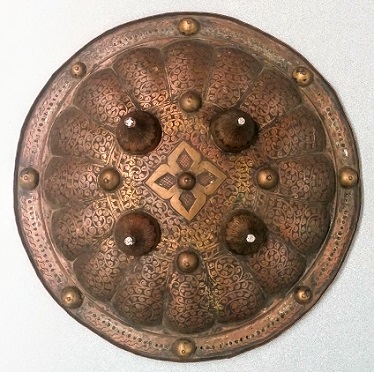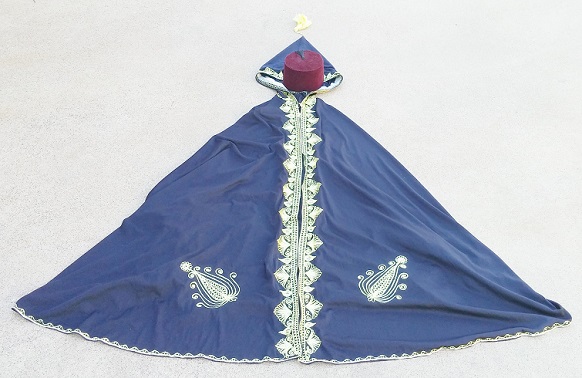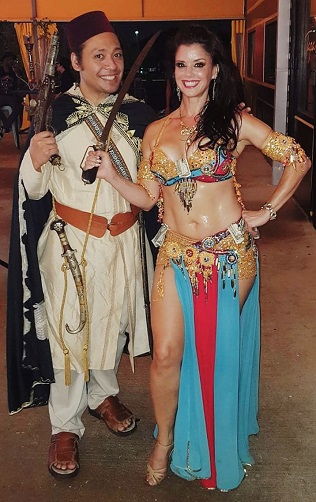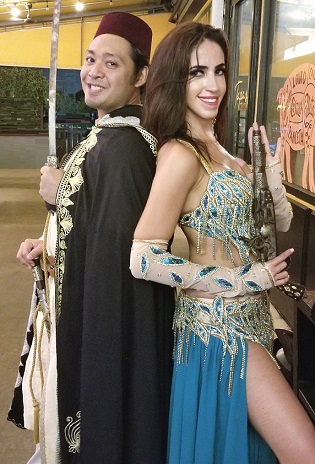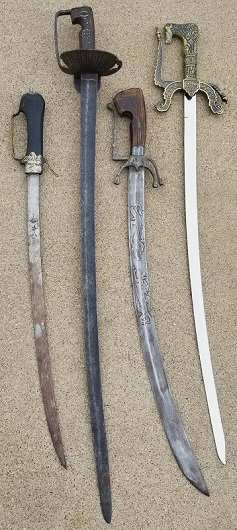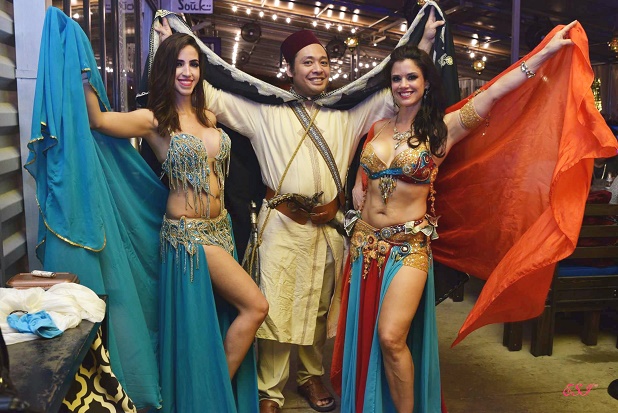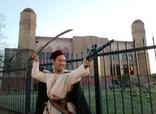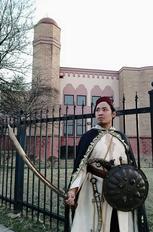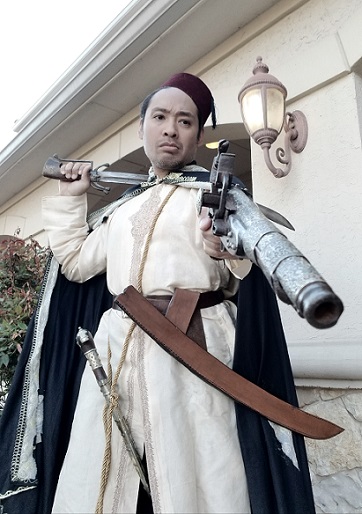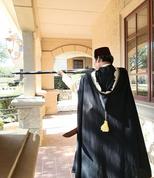Subject: غازى ġāzī desert raider
Culture: Moroccan
Setting: French/Spanish/civil wars, Morocco 1844-1912
Evolution:
Context (Event Photos, Period Sources, Secondary Sources, Field Notes)
* Burke 1976 p20
"The French invasion of Algeria in 1830 had set in motion a series of events that would by the end of the century lead to the undermining of the traditional system and the emergence of a new, precolonial Morocco. But the implications of the French presence in Algeria were for a long time not grasped by the Moroccan elite. Even the French victory at the battle of Isly in 1844 over a Moroccan army commanded by Muhammad IV produced few echoes in makhzan circles. Since the defeat occurred on the eastern frontier of the empire and France refrained from following up its victory, Moroccans were not compelled to recognize the full extent of their military inferiority. Following the battle of Isly, European commercial penetration of Morocco began to increase, and the first traits of the precolonial economic system appeared. From this time on, European merchants and speculators became increasingly aggressive in asserting their rights, the trade balance started to shift away from Morocco, and the monetary and financial situation of the makhzan became increasingly precarious. By the eve of the Hispano-Moroccan War of 1859-60, the economic stability of the country was already in jeopardy, and the first signs of the decay of the old structures were already visible to sharp-eyed European observers.
Costume
* Fashion, costume, and culture 2 2004 p430
"The fez cap is popular among northern Africans, especially men, of various nationalities, religions, and tribal affiliations. The cap is a small, brimless, flat-topped cap that fits above the ears on the top of the head. The cap was named for the city of Fez, Morocco, and a red fez, or tarbouch, has become a national symbol of that country."
Musket
* North 1985 p20
"The standard gun of the Maghreb was very long; the capucines holding the barrel to the stock being formed as simple round bands with as many as twenty-five being used on some guns. The barrel was usually imported and the stock was flat with a profile resembling Northern European guns. The stock is mounted in brass or steel set with crudely engraved bone or ivory plaques and overlaid with silver bands. The use of coloured composition in the stock, usually red, is often found. Guns of this type were still being made and sold in the bazaars of Marrakesh this century. The English explorer Fawcett equipped himself with one when on a spying mission to Morocco before the first World War."
* Richardson 2015 p76
"A wide variety of firearms was produced in Islamic north Africa. The north of Morocco around Tetuan produced a smooth bore long-gun called the mukhala, with a wide flaring butt and a snaphance lock. The locks of these guns are thought to be based on seventeenth century guns imported from England or the Netherlands, and continued to be made into the 19th century. They are found in most Moroccan long guns. Their stocks are usually decorated with inlaid silver wire, and their butt caps of ivory. The same name is used for regional types of snaphance lock long gun in Morocco. In central Morocco, in the Sous valley, centred on Ras el Oued, were made the taouzilt form of the mukhala, fitted with slightly flaring, slightly down-turned butt with a thumb notch, and teh stocks covered in tooled silver sheet or studded with silver nails, and the same snaphance locks. From teh same region comes the affedali, which also has a snaphance lock, and a narrow flaring butt, often decorated with camel bone or ivory inlaid panels. These are thought to have been made in the walled city of Taroudant in central Morocco. The altit form of mukhala, with a slightly curved stock, often with a concave butt like the Balkan rasak, comes from the far south of Morocco, in the Anti-Atlas Mountains."
Pistol
* Stone 1934 p503
"In Morocco and North Africa most of the pistols were European, or like the Turkish, except for the decoration. The stocks were often inlaid with wire scrolls or with rather large pieces of brass or steel. Pistols apparently of native make were also used. These had snaphaan locks, like those of the Berber guns, and peculiar oval pommels."
* Wilkinson-Latham 1977 p35
"[T]he use of the snaphaunce was spread by the Dutch with their vast trading fleets to the Mediterranean and shores of North Africa, and locks or finished guns exported to Morocco. Later when the inhabitants became proficient in making their own weapons, they either imported locks only or made passable copies themselves. Even as late as the 1880s snaphaunces were still being made and sold in Morocco and even today these items are manufactured for the tourist trade."
* North 1985 p20
"Most of the pistols used in the region were either made up from imported elements, English locks and barrels being especially popular, or were imported as complete pieces then decorated locally."
Saber
* North 1985 p29-30
"The classic sword of the area is the 'Nimcha'. This has more than a hint of European influence especially in the form of the hilt, which is fitted with a knuckle bow linked to curved quillons. These hilts are found mounted with straight and curved blades[;] the straight blades were usually imported from Europe. This type of sword continued in use until the 19th century."
* Richardson 2015 p69
"The sword of the coastal kingdom of Morocco is the nimcha, a sabre with a curved single-edged blade and a notched hilt with forward curving quillons, almost indistinguishable from the Arabian saif. These frequently have European blades, mostly French."
* Spring 1993 p24
"The nimsha includes elements from both Islamic and European swords in a synthesis which is nonetheless distinctively African. A diagnostic features of many Islamic swords is the cap pommel set at an angle at the top of the grip. In the nimsha this appears as an enlarged and ornate extension to protect the back of the hand. The grip, often of rhinoceros horn or ivory traded across the Sahara, sometimes included a hollowed-out section to accommodate the little finger. By contrast, the form of the four quillons, three curving downwards and the fourth bent back to form a knuckle guard, is suggestive of southern European models, particularly the fifteenth- and sixteenth-century Spanish swords whose influence may also be seen among those weapons produced in the region of the ancient kingdom of Kongo on the lower Zaire river. The nimsha began to appear from the late sixteenth century and was at first mounted with straight, European blades often of Venetian or Genoese provenance. A shorter, curved version, of entirely local manufacture, was developed during the seventeenth century for use as a naval cutlass." [references omitted]
* Stone 1934 p469
"NIMCHA. An Arab sabre with a knuckle guard rectangular at the base with drooping quillons on the opposite side. It is also used in Morocco." [references omitted]
* Fryer 1969 p88
"Nimcha A Moroccan sabre. The hilt has a broad grip with angled pommel, a right-angled knuckle-bow and down-dropping quillons."
Dagger
* Richardson 2015 p70
"The matching Moroccan dagger is the koummya, with a double-edged, curved blade with most of the concave edge but only half of the convex edge sharpened, and a long, slender hilt formed of horn, ivory or bone panels with a lunate pommel, the scabbard and mounts usually of brass and silver with engraved and chased decoration."
* Stone 1934 p310
"In Morocco the blades are straight and single-edged for about half their length from the hilt, and then curved and double-edged for the remainder. They seldom have ribs. The hilts and scabbards are usually of brass or silver, often the front is of silver and the back of brass. The scabbards frequently curve so much that the ends point upwards. There are almost always large ornamental lugs on the sides that carry large rings to which a cord is fastened by which the knife is hung from the neck. The hilts are usually made entirely of metal and have large, flat pommels. The side of the hilt and scabbard that is outward when the knife is carried is always elaborately, though crudely, decorated. The opposite side is much simpler, in fact, in many cases it is entirely plain."
* Spring 1993 p24
"There are a number of Moroccan variations of the type of dagger collectively known as janbiyya which form an essential element of the formal attire of every adult man in Arabia and the Maghrib countries of North Africa. As with the nimsha, the blades of Moroccan daggers are frequently fitted with European blades, including examples made in Sheffield and Birmingham in England, and Solingen in Germany. The koummya, with its distinctive 'peacock's tail' pommel, is found in a number of variant forms in the Sous region and the Atlas mountains of Southern Morocco. Like the nimsha and the Tuareg takouba, the koummya, is worn on the left side by means of a baldric slung over the right shoulder. The Arabian janbiyya, by contrast, is normally worn in a belt on the front of a man's stomach."
* Tarassuk/Blair 1979 p284-285
"In Morocco, jambiya blades were straight and single-edged for about half their length from the hilt and curved and double-edged for the remainder, seldom with fullers. The hilt had a large, flat pommel of the form known as a 'peacock's tail.'"
Amulet
*
"
Bottle
*
"
Shield
*
"
Knife
*
"
